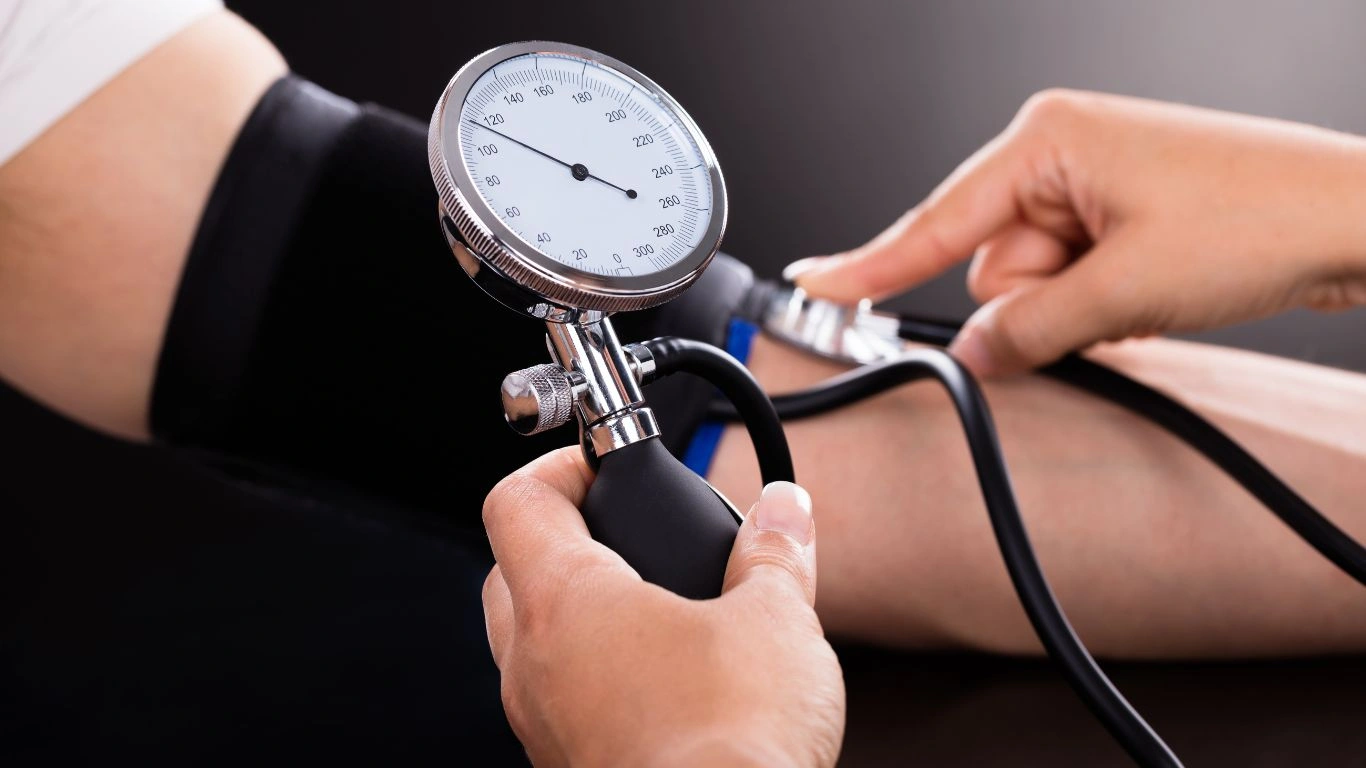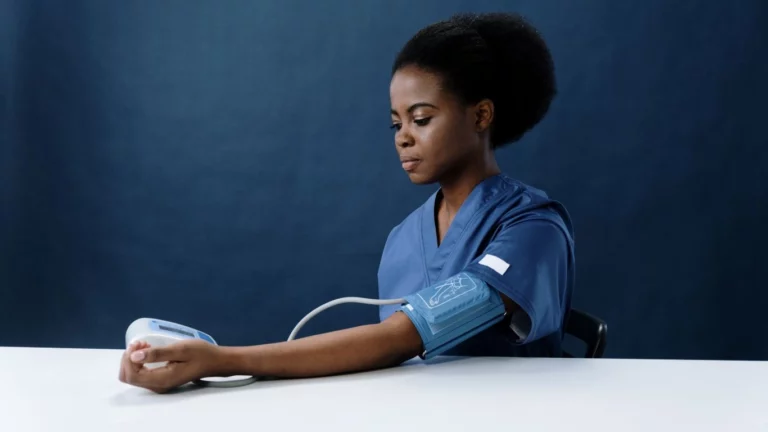How High Blood Pressure Triggers Vertigo and What You Can Do About It
High blood pressure, also known as hypertension, is often referred to as the “silent killer” because it can quietly cause severe damage to your heart, kidneys, and arteries without showing any noticeable symptoms. But did you know that one of the lesser-known consequences of hypertension can be vertigo or dizziness? If you’ve been experiencing a feeling of lightheadedness, a spinning sensation, or unsteadiness, these could be signs of high blood pressure affecting your inner ear or brain. In this post, we’ll explore how high blood pressure and vertigo symptoms are linked and what you can do to manage both effectively.
What’s the Connection Between High Blood Pressure and Vertigo?

First off, let me tell you, it’s not uncommon for someone with hypertension to experience vertigo or dizziness. While vertigo is typically associated with issues related to the inner ear or the brain’s balance centers, high blood pressure can play a significant role in triggering these symptoms. It’s a classic case of how your circulatory system can influence other parts of your body in unexpected ways.
When your blood pressure is consistently high, it forces your heart to work harder to pump blood through your arteries, which can lead to a number of other issues. One of the main reasons high blood pressure can cause dizziness is because it may affect the blood flow to your brain, depriving it of oxygen and causing that disorienting feeling. Imagine your brain is like a busy intersection, and high blood pressure can sometimes act like a traffic jam. This lack of smooth blood flow can lead to vertigo and other neurological symptoms.
From my experience, many people are surprised when they discover that their vertigo symptoms might actually be tied to hypertension, especially since the dizziness can often seem unrelated to their blood pressure. But once we start focusing on their hypertension management, the dizziness tends to improve or even disappear.
Common Vertigo Symptoms You Should Watch Out For

Vertigo symptoms can vary from person to person, but they typically fall into two main categories: a sensation of spinning or a feeling of unsteadiness. When high blood pressure is the cause, vertigo might come on suddenly or last for a few seconds to a few minutes. Here’s a quick list of the most common vertigo symptoms you should be aware of:
- Feeling of Spinning: This is probably the most classic vertigo symptom, where it feels like the world around you is moving, even though you’re standing still.
- Lightheadedness: You may feel faint or weak, like you’re about to pass out.
- Lack of Coordination: Some people experience difficulty walking or balancing, which can make performing daily activities dangerous.
- Headaches: Sometimes, high blood pressure-induced vertigo can come with a headache, which can make it harder to differentiate between the two symptoms.
- Nausea or Vomiting: The spinning sensation can lead to queasiness or, in some cases, even vomiting.
If any of these symptoms are happening frequently or seem to be affecting your day-to-day life, it’s definitely worth bringing up with your doctor. In many cases, these symptoms can be controlled once the underlying high blood pressure is addressed. Don’t ignore dizziness—it’s more than just a nuisance. It’s your body trying to tell you that something may be off.
How High Blood Pressure Triggers Vertigo: The Science Behind It

Understanding the science behind the connection between high blood pressure and vertigo can be a game changer in how we approach both conditions. Here’s the deal: when your blood pressure is too high, it can cause damage to the tiny blood vessels in your brain, inner ear, and other areas involved in balance and coordination. This impaired blood flow can directly affect your vestibular system, which is responsible for your sense of balance. When the vestibular system isn’t functioning properly, it can lead to vertigo or dizziness.
Another issue is that high blood pressure increases the likelihood of other health problems, such as strokes, aneurysms, or even inner ear infections, which can exacerbate vertigo symptoms. If you already have a history of vertigo or other balance disorders, the added stress of high blood pressure can worsen these issues.
But here’s the good news: By controlling high blood pressure, you can significantly reduce or even eliminate vertigo symptoms. I’ve seen this happen countless times in my practice. Once blood pressure is under control, dizziness caused by it often fades away. So, if you’re dealing with both of these issues, focusing on managing your blood pressure is a big part of the solution!
Is Vertigo a Common Symptom for Those with High Blood Pressure?
It might not be something people talk about a lot, but yes, vertigo is a relatively common symptom among people with high blood pressure. Of course, it doesn’t mean that everyone with hypertension will experience vertigo, but it’s definitely something to be aware of. The combination of age, prolonged hypertension, and other risk factors like smoking or lack of exercise can increase the likelihood of experiencing both vertigo and high blood pressure.
In fact, in my experience working with patients, many have been shocked to learn how much better they feel once their hypertension is managed. Not only does their blood pressure improve, but their balance and dizziness often follow suit. So if you’re dealing with high blood pressure and vertigo, it’s absolutely worth having a discussion with your healthcare provider about treatment options that address both conditions.
Managing High Blood Pressure to Prevent Vertigo

Now that we know how high blood pressure can lead to vertigo, let’s talk about how to manage both. The good news is that with the right approach, you can significantly reduce your blood pressure—and hopefully, those annoying dizziness symptoms along with it. Managing high blood pressure doesn’t have to be overwhelming, but it does require a multi-faceted approach. Here’s a rundown of what’s worked best for many of my patients, including some personal tips I swear by.
1. Lifestyle Changes: The First Step
If you’ve been struggling with high blood pressure and vertigo, the first thing I suggest is always lifestyle changes. I know, I know, you’ve probably heard it a million times, but trust me—small adjustments can make a huge difference.
Diet is key. Cutting back on salt is one of the most important changes you can make. Too much sodium increases blood pressure, and we definitely don’t want that! I recommend reducing processed foods and switching to a diet rich in fruits, vegetables, whole grains, and lean proteins. I love recommending the DASH diet (Dietary Approaches to Stop Hypertension), which focuses on reducing sodium while increasing nutrient-dense foods.
Another simple but effective tip? Increase potassium intake. Potassium helps balance out the effects of sodium in your body and can help lower blood pressure. Foods like bananas, sweet potatoes, spinach, and avocados are all potassium-rich options. I’ve seen patients feel better just by making these two dietary tweaks alone.
Physical activity is a game changer. Regular exercise—like walking, swimming, or even yoga—can lower blood pressure and improve overall cardiovascular health. I always tell my patients to aim for at least 30 minutes of moderate exercise most days of the week. Don’t worry, you don’t have to become a gym rat to see results. Consistency is what matters!
2. Medications: When Lifestyle Changes Aren’t Enough
Sometimes, despite your best efforts with lifestyle changes, your blood pressure may still remain high. In these cases, your doctor may prescribe medication to help bring it down. There are several classes of medications used to treat high blood pressure, and I’ve seen firsthand how effective they can be.
Some common types of blood pressure meds include:
- Diuretics (Water Pills): These help eliminate excess sodium and fluid from your body, reducing the strain on your heart.
- ACE Inhibitors: They help relax blood vessels and improve blood flow, which lowers blood pressure.
- Beta Blockers: These reduce heart rate and the force of each heartbeat, which can lower blood pressure.
- Calcium Channel Blockers: These help relax and widen blood vessels, making it easier for blood to flow through.
Medication isn’t a one-size-fits-all solution, so if you’re prescribed something, make sure to follow up with your doctor to ensure it’s the right fit for you. I’ve worked with many people who experience dizziness or vertigo when adjusting to new medications, so don’t be afraid to talk to your doctor about any side effects you may experience. There are alternatives if one medication doesn’t work for you.
How to Cope with Vertigo While Managing High Blood Pressure

Managing high blood pressure can go a long way in alleviating vertigo symptoms, but in the meantime, there are strategies to help cope with dizziness when it strikes. Vertigo can be disorienting, and when you add high blood pressure into the mix, it can feel like a double whammy. However, with a few techniques, you can get through the tough moments and stay safe while dealing with both issues.
1. Sit or Lie Down Immediately
If you start feeling dizzy or lightheaded, the best thing you can do is sit or lie down as quickly as possible. This helps prevent the risk of falling and can make you feel a little more stable. I always tell my patients that it’s better to sit and wait it out than try to push through the dizziness. If you’re already in a standing position, find a place to sit or, better yet, lie flat with your feet elevated to help improve blood flow to the brain.
2. Hydrate, Hydrate, Hydrate
Dehydration is often an overlooked factor when it comes to vertigo and blood pressure. When you’re dehydrated, your blood pressure can drop, which can exacerbate dizziness. Keep a water bottle handy throughout the day, especially if you’re out and about. Staying hydrated helps maintain blood flow and can help prevent those sudden, dizzying moments. I’m a big fan of infusing water with a slice of lemon or cucumber—refreshing and good for your circulation!
3. Take Your Time When Standing Up
One thing I’ve personally found helpful is avoiding sudden movements, especially when standing up. If you’ve been sitting for a while, take your time getting up. Stand slowly, and give your body a moment to adjust. This technique is particularly useful for people who experience what’s called postural hypotension—a sudden drop in blood pressure when standing up. It’s a common side effect of high blood pressure, and it can easily trigger dizziness. Slow and steady wins the race!
4. Focus on Deep Breathing
Deep breathing exercises are another simple yet effective way to manage vertigo symptoms. When you start feeling dizzy, try focusing on your breathing to help calm your nervous system. I recommend breathing in for a count of four, holding for four, and exhaling for four. This kind of steady breathing helps regulate blood flow and can relieve some of the dizziness caused by high blood pressure. It’s also a great tool for reducing stress—another common culprit of hypertension.
When to Seek Medical Help

While most vertigo caused by high blood pressure can be managed at home, there are times when you should seek medical attention. If your dizziness becomes severe, persists for a long period, or is accompanied by other symptoms like chest pain, fainting, or difficulty speaking, it’s crucial to get immediate medical care. These could be signs of a stroke or other serious conditions, especially if your hypertension is poorly managed.
Don’t ignore your body when it’s trying to tell you something. If you’re feeling persistent dizziness or if your blood pressure readings are consistently high, make an appointment with your healthcare provider as soon as possible. It’s always better to be safe and proactive when it comes to your health.
Building a Long-Term Plan for Managing High Blood Pressure and Vertigo

As we’ve discussed, managing high blood pressure and vertigo isn’t just about quick fixes—it’s about creating a long-term strategy that includes lifestyle changes, medication, and constant monitoring. The good news is that with the right approach, you can take control of both conditions and significantly improve your quality of life. In this final section, let’s talk about the key elements of a long-term plan that can keep you feeling your best while preventing both hypertension and vertigo from taking over.
1. Ongoing Monitoring of Blood Pressure
One of the best ways to stay on top of your hypertension and ensure you’re not caught off guard by a sudden rise in blood pressure is by regularly monitoring your numbers at home. I’m a huge advocate for home blood pressure monitors—they’re affordable, easy to use, and can provide real-time insights into how well your lifestyle changes or medication are working.
Investing in a good-quality blood pressure cuff is an essential step in your long-term management plan. Keep track of your readings and share them with your doctor at your regular appointments. This allows you both to make adjustments as needed and helps you stay proactive about your health.
Remember, blood pressure fluctuates throughout the day, so don’t get discouraged if your reading is higher at one point. Just try to monitor at the same time each day and follow any guidance from your healthcare provider about when to check.
2. Stay Consistent with Lifestyle Modifications
Changing your lifestyle to manage high blood pressure and vertigo isn’t a one-time fix—it’s a continuous effort. I know it can be tempting to slack off after a few weeks of feeling better, but consistency is key to long-term success. Here’s what I suggest:
- Stick to Your Diet Plan: Continue following the DASH diet or other dietary recommendations. Keep limiting salt, eating potassium-rich foods, and incorporating heart-healthy fats like those found in olive oil, avocados, and nuts.
- Regular Exercise: Make exercise a regular part of your routine. It doesn’t have to be intense; just keep moving! Whether it’s a brisk walk in the park or swimming, find something you enjoy.
- Manage Stress: Chronic stress can elevate your blood pressure and trigger vertigo symptoms. I recommend finding stress-reduction techniques that work for you, whether it’s meditation, deep breathing, or simply taking time for hobbies you enjoy.
I know maintaining these habits can feel like a lot at first, but after a while, they’ll become second nature. When you start seeing the benefits—like improved energy, fewer dizzy spells, and better overall health—it’ll be worth it.
3. Regular Check-Ups with Your Doctor
Regular check-ups with your healthcare provider are a must when managing high blood pressure and vertigo. Even if you’re feeling great, these appointments are essential for keeping track of your blood pressure, checking your heart health, and making sure your vertigo symptoms are under control. If you’re on medication, your doctor will also want to monitor any potential side effects or make adjustments to your prescription as needed.
I always stress to my patients that having open communication with their doctor is critical. If you’re experiencing any new symptoms, changes in your vertigo, or side effects from medication, be sure to share those with your healthcare provider. They’re there to help you and ensure you’re on the best path to managing both conditions.
Addressing Vertigo Through Specialized Treatments

While managing high blood pressure can often alleviate vertigo symptoms, there are cases where specialized treatments are necessary to directly address the vertigo itself. If you’ve been dealing with persistent dizziness despite managing your hypertension, you might need to explore treatments specifically for vertigo.
1. Vestibular Rehabilitation Therapy (VRT)
If vertigo continues to be a problem, Vestibular Rehabilitation Therapy (VRT) is one of the most effective treatments. VRT is a specialized form of physical therapy designed to help people with balance disorders, like vertigo. The therapy focuses on exercises that improve balance, reduce dizziness, and help retrain the brain to process signals from the inner ear. I’ve worked with several patients who’ve found VRT to be a life-changing treatment, especially when traditional approaches didn’t seem to help.
If vertigo is severe or chronic, ask your doctor if VRT might be an option for you. It’s typically done under the guidance of a trained specialist, but many patients report significant improvements after a few weeks of therapy.
2. Medications for Vertigo
In some cases, medications may be prescribed specifically to manage vertigo. Medications such as meclizine or diazepam can help control dizziness or nausea associated with vertigo. These are typically used for short-term relief during an acute episode of dizziness. However, long-term reliance on medications for vertigo is usually not recommended, especially if high blood pressure is the underlying cause.
If vertigo is a frequent issue for you, it’s important to have an open conversation with your doctor about the best way to manage it while keeping your blood pressure under control. Your doctor may also suggest medications to help stabilize blood pressure that could also reduce vertigo episodes over time.
3. Surgery: A Last Resort
In rare cases, when vertigo is caused by a structural issue in the ear or brain, surgery may be needed. However, this is typically a last resort after all other treatment options have been explored. Fortunately, for most people with high blood pressure-induced vertigo, surgery isn’t necessary. But if you’ve tried everything else and haven’t seen any improvement, it’s worth discussing surgical options with your doctor.
Understanding the Importance of a Holistic Approach
When it comes to managing both high blood pressure and vertigo, a holistic approach is often the best path. It’s not just about taking a pill or going to therapy—it’s about addressing all the factors that contribute to your well-being. That includes your physical health, mental health, stress levels, sleep, and overall lifestyle. By focusing on each of these areas, you can create a comprehensive, long-term plan that not only controls your blood pressure and vertigo but also improves your overall quality of life.
Over the years, I’ve worked with many patients who’ve struggled with high blood pressure and vertigo, and the ones who have the most success are the ones who commit to a balanced approach. There’s no magic pill or one-size-fits-all solution, but by combining lifestyle changes, medications, and specialized treatments, you can absolutely manage both conditions and live a full, active life.
References
If you’re looking for more information on hypertension and vertigo, check out these resources:
- Comprehensive Hypertension Management
- CDC: Stroke Prevention and Symptoms
- American Heart Association: Managing High Blood Pressure
Disclaimer
The information provided in this article is for informational purposes only and is not intended as medical advice. Always consult with a qualified healthcare provider for the diagnosis and treatment of medical conditions. If you’re experiencing persistent symptoms or need personalized care, reach out to your doctor.

Dr. Gwenna Aazee is a board-certified Internal Medicine Physician with a special focus on hypertension management, chronic disease prevention, and patient education. With years of experience in both clinical practice and medical writing, she’s passionate about turning evidence-based medicine into accessible, actionable advice. Through her work at Healthusias.com, Dr. Aazee empowers readers to take charge of their health with confidence and clarity. Off the clock, she enjoys deep dives into nutrition research, long walks with her rescue pup, and simplifying medical jargon one article at a time.






